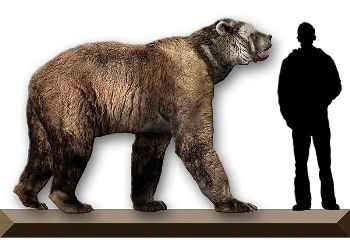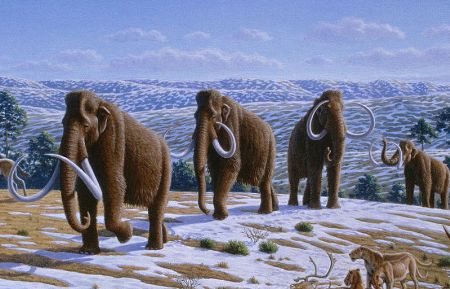by Larry
February, 2011The Late Great North American Megafauna
The creatures they found in this new world no doubt posed hurdles to such ongoing expansion. Some varieties of them presented significant challenges to our ancient relations' continued existences. These included the fairly well known mastodons and woolly mammoths, larger in most instances than their distant relatives, the African elephants of today. They also included terratorns, flying fowl with 12-foot wingspans. There were packs (most likely) of tusked peccaries, the males weighing probably about 300-350 pounds. There were species of wild horses, giant beavers, huge ground sloths, and llamas. There were bison weighing 2000 pounds, with heads like battering rams, sharp horns, aggressive temperaments, and maximum speeds of about 30 MPH. Though grazing animals, herds of bison are thought to have been almost the deadliest megafauna of the time to humans, second only to the giant short-faced bears, monsters about 67% larger than today's grizzlies. Other bears then included an oversized species of polar bear, its males weighing about 1.2 tons. There was a coastal species of muskox, also larger than today's version. There were stag-moose, resembling a cross between an elk and a moose but more massive than either. There were American cheetahs (not true cheetahs), saber-toothed cats, their males weighing up to about 1100 pounds, and American lions, thought to have been 25% bigger than present day African lions. Particularly in the days before fire in human encampments or until more effective weapons than stones and sticks were common, dire wolves may have been a cause for concern. Like modern wolves, these almost certainly were cunning and worked together in attack or defense teams. Males weighed about 240 pounds. It has been popularly suggested that many varieties of North American megafauna were primarily rendered extinct by us, that is by those early peoples then becoming native to a new continent opening up before them. Yet, most of the megafauna that the early native populations of our continent encountered continued to exist until but 11,000 to 10,000 years ago, only disappearing after radical alterations in the climate. If humans had been around since at least 3000-4000 years earlier, why did it take them so long to do in the large mammals all around them? While this controversy over climatic stressors vs. human ones being responsible for the mass extinctions of Pleistocene species may never be completely settled, it seems plausible that rising global temperatures at the end of the last ice age adversely affected the food, range, or other niche aspects of vegetation consuming creatures here, and that their dwindling numbers also put pressure in turn on the carnivores who had depended on them for food.
Essentially coincident with these trends, rising temperatures likely enhanced life for the more adaptable Homo sapiens species and so increased our own chances of survival. As we found we had more leisure time, the luxury of specializations arose within human cultures, leading to still further abilities to exploit our improving environments, defend against dangerous animals, wipe out those which adverse climatic conditions had already made susceptible, and gradually establish more practical means of governing ourselves, passing on knowledge, skills, language, codes of ethics, moral stories, traditions, etc., thus in the end leading to the overall improvement and civilizing of societies. What the climate has given, in the form of the more favorable conditions that began roughly 18,000 years ago, it can now take away, as the resumption of either global warming or of a new cycle of global cooling may create fresh challenges for a population dependent on its circumstances being far more friendly than they are likely to be again for a long while. In view of this state of affairs, we ourselves may be among the North American megafauna (literally just large animal species, generally those weighing 100 pounds or more) threatened, unless we too can quickly migrate or adjust, as in the 21st Century new rounds of mass extinction are now proceeding apace. Yet, meanwhile, let us think positively. Consider that for well over 100,000 years, 5000 generations, the Pleistocene creatures were thriving. One day perhaps we shall do a piece on a seldom researched or reported topic, the Pleistocene babies, featuring all the cute little mammoth, saber-toothed, lion cub, tiny peccary, dire wolf pup, short-faced bear cub, and other sweet and cuddly but seldom celebrated wee-one offspring of the last ice age. Likely the spiritual traditions of early North American peoples were enhanced through their recognitions of an essential kinship with all living things, a link made easier by seeing and appreciating the love they and their other megafauna parents shared for the young of their kind. Our early American Indian forebears, however, lacking a functional wheel, domesticated cattle, efficient ovens, harvestable crops, either bows and arrows or firearms, or (likely) even the protection of pet dogs, could not have afforded to be sentimental. It was certainly at times a very close thing whether they killed and ate the most vulnerable of their wildlife adversaries or lost their own babies to them. And who knows? Perhaps the thousands of years' struggle around the globe between our ancestors and their fiercest opponents helped shape who we are today, creatures at once capable of great violence, enobling compassion, and acute intellectual and intuitive insights. |

